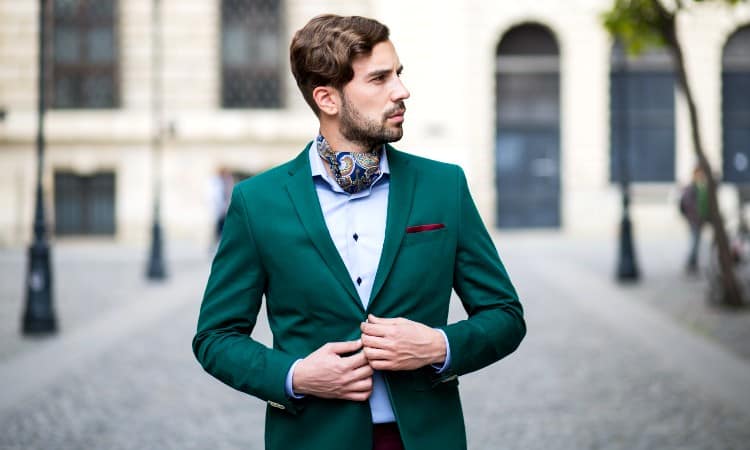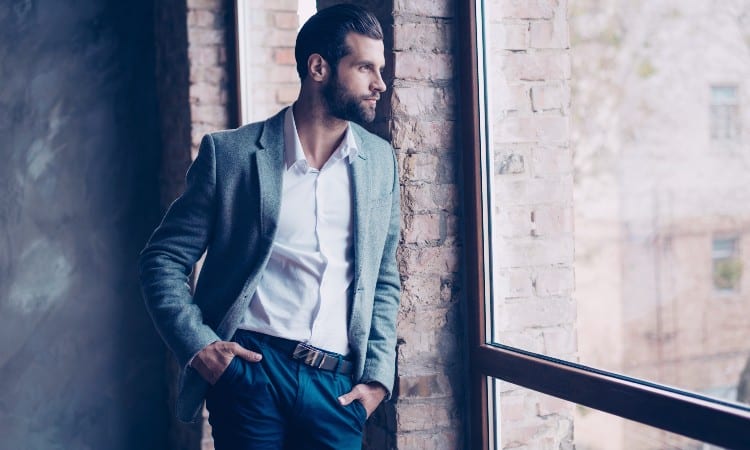In the post-pandemic era, workplace fashion shifted to less formal, more comfortable styles. But even if you love leaving the tie at home, you may find yourself confused about casual office attire. For example, when you compare smart casual vs business casual, what exactly is the difference?
The key difference between smart casual and business casual is that smart casual has a less formal appearance than business casual. Business casual often includes a button-down shirt, khakis, or a blazer and shirt worn without a tie. Smart casual can feature jeans, a polo shirt, a blazer, or even sneakers.
In this article, you will learn what defines smart casual and business casual. You will discover the important distinctions between these two workplace styles. Finally, you will find tips to help you decide which style works best for you.

Smart Casual vs Business Casual: Key Points
Check out this handy guide to get a quick overview of the most common differences between smart and business casual.
| Smart Casual | Business Casual | |
|---|---|---|
| Style | Unique and personalized, matching formal garments with less formal garments like jeans paired with a blazer | Not as formal as a traditional suit and tie, but very professional, matching button-down shirts with slacks or pencil skirts |
| Tops | Can vary, including t-shirts, polo shirts, button-downs, and sweaters | Usually limited to button-downs, sweaters, or sweater vests over button-downs |
| Jeans | Can work well when paired with more formal tops | Usually not allowed |
| Shoes | Can vary, ranging from sneakers to heels | Usually low-key, formal footwear like loafers and ballet flats |
| Jacket or Blazer | Work well when paired with a less formal shirt such as a t-shirt | Often forms a key component of a business casual style, paired with slacks or khakis and a dress shirt |
| Color Palate | Fun quirky, bright, and exciting colors and patterns all work well for this style | Mutued colors, simple patterns, or solids work best for the understated professionalism of this style |
| Best For | After hours or off-sight work events, or more informal settings | Most workplaces, offices, and schools for day-to-day wear. |
What is Smart Casual?

Smart casual mixes low-key attire like sneakers and jeans with traditional business wear like polos, button-downs, and blazers. This trendy workplace style has its roots in a Millennial desire for comfort as well as the changes to the workplace caused by the pandemic. It has a less formal overall vibe than business casual.
Smart casual has a young feel to it because of its modern roots, but actually, business people have done things like wearing sneakers on the train to work for a long time. This style has slowly made those comfortable, modern innovations OK within the office and outside on the street.
You don’t have to have a birthdate in the 80s, 90s, or 2000s to get away with wearing smart casual, either! While you can thank the younger workplace generations for the innovations of this style, smart casual has gained such popularity that this more informal style is acceptable for all ages under some circumstances.
Not every office or workplace has signed off on a smart casual dress code. You can always get away with wearing this more low-key style to an after-hours workplace event or a networking occasion, but you should check your workplace dress code to find out if you can leave the suit and tie at home!
A few popular ways to wear smart casual for women include:
- Pairing chinos and a brightly colored blouse.
- Dark-wash jeans with a button-down and ballet flats.
- A sheath dress worn over a long-sleeve button-down.
For men, try wearing a brightly-colored button-down (no tie) with either khakis or dark jeans. You can also match a polo shirt with a blazer and dress pants. If you want to push the limits and wear sneakers, try pairing them with nice jeans and a crisp dress shirt.
The advantage of this style is that it often costs less than business casual clothing and feels more comfortable. The disadvantage is that you cannot always wear smart casual to the workplace, depending on the dress code.
What is Business Casual?

Business casual fashion encompasses most workwear with a little less formality than a suit and tie. It maintains a more formal appearance than smart casual, largely because it more or less just modifies traditional office wear for a little more comfort and less rigidity. That said, business casual also has a fairly short history, as it stems from the heyday of Silicon Valley in the 1980s.
During the 80s, young people gained more power in the business world than ever before because, by and large, younger people led the development of the internet and all the many dot-com businesses it launched. This led to the emergence of a more casual code for workplace attire, as young programmers did not like the constraint of wearing a full suit and tie to the office.
By the 1990s, many offices considered business casual the norm rather than an outrageous informality. By the 2000s, HR in large organizations typically included descriptions of business casual in the employee dress code.
So, what does business casual look like? It often includes a nice sweater or a button-down shirt with a collar for both men and women. You can wear a blazer over the shirt or even over the sweater for a preppy look. For bottoms, business casual typically focuses on dress pants, chinos, or pencil skirts.
While you can get away with classy sandals for a summery business casual, you would more often wear closed-toe shoes like loafers or flats with this style.
While you can find exceptions to this rule, you typically would not wear bold colors or vivid patterns with this style, either. Instead, focus on solid colors or simple patterns. Strive for a put-together, sleek style all over, from your hair to your classy accessories to your nice shoes.
The big advantage of business casual attire is that most workplaces accept it for daily wear, and it feels more comfortable than the traditional business style.
What’s the Difference Between Smart Casual vs Business Casual?

The main difference between smart casual and business casual is that smart casual has a more informal appearance than business casual. Smart casual may include sneakers, jeans, or knit shirts. Business casual usually features items like slacks and button-down shirts with no tie.
Of course, you will see that both styles have some similarities and the lines between them can blur quite a bit. As with most fashion questions, you don’t always find a clear-cut answer! But in general, you can look for key differences between smart and business casual styles.
Style
The key difference between the style of business casual and smart casual is that business casual has an overall professional appearance, while smart casual has more of a personalized or trendy appearance. In general, smart casual also focuses more on comfort items than business casual.
While business casual shies away from old-school suits with a matching jacket and pants, it does embrace a stiffer, more formal dress style. Workplaces that specify a “business casual” dress code typically accept any kind of button-down shirts, slacks, and skirts but might not sign off on polo shirts or t-shirts.
Another hallmark of business casual’s professional style is that it avoids baggy or too-tight loathing. You want a fitted, sleek style that does not reveal too much or look sloppy.
The overall style of smart casual embraces a bit more whimsy. You can pair a t-shirt with a blazer, or jeans with a nice dress shirt. The idea is to match an old-school item with a more modern and comfortable one.
You can get away with wearing nice Sketchers or Adidas sneakers if you pair them with dark jeans, a sweater, and a blazer. Or you can wear a t-shirt supporting your favorite band, so long as you match it with a nice sweater or blazer!
Tops
Both business casual and smart casual work well with tops like button-down shirts, but smart casual allows a wider range of types of tops than business casual overall.
The best tops for a business casual style include button-down shirts, sweaters, and vests. Avoid knitwear like polos or tees, but you can feel free to leave the top button of a dress shirt undone!
For smart casual, you can display your own personality a bit more through boldly colored or patterned tops. Depending on how formally people dress at your workplace, you can try out poofy blouses, crop tops beneath a suit jacket, or polo shirts paired with nice jeans or khakis. In some cases, you can even get away with wearing a t-shirt beneath a blazer, though you should feel the general style vibe at your workplace before trying that!
Jeans
You can wear jeans in a smart casual outfit but not a business casual outfit. Generally, dress codes that specify “business casual” do not allow jeans, t-shirts, or sneakers. Smart casual loves to pair informal items with more formal ones, though, so you can safely wear a nice pair of jeans so long as you match them with a more formal garment, like a button-down shirt.
That said, unless you have a side job as a celebrity or a fashion model, you should avoid ripped, distressed, baggy, or faded-looking jeans. Look for fitted jeans in a dark wash or black shade. This crisper, slightly more formal appearance will pair nicely with a dress shirt.
Shoes
Both smart and business casual styles generally work best with semi-formal shoes like Oxfords, loafers, ballet flats, low heels, or nice boots.
That said, you can find your style here to a certain extent. Smart casual can sometimes work with nice sneakers or fancy heels–you just want to make sure you pair the fancy heels with lowkey jeans and the sneakers with a more formal top like a blazer. You can also get away with fun colors and patterns in your footwear in a smart casual style.
Your best bet for business casual is to keep your footwear low-profile. Look for simple, basic shoes like loafers or ballet flats in solid, muted colors.
Jacket or Blazer
You can wear a sport coat or blazer with both a business casual and a smart casual outfit. The difference is that you would wear a blazer over a dress shirt and slacks for business casual, while you would pair a blazer with a t-shirt and slacks or a dress shirt and jeans for a smart casual vibe.
A blazer serves as one of the classic symbols of business casual. The blazer is the less formal younger brother to the stiffer, more old-fashioned suit jacket. Wearing a blazer instead of a full matching suit indicates a slightly more laid-back vibe. But because business casual still maintains a carefully professional appearance, you will still pair the blazer with a nice dress shirt and slacks.
For smart casual, you wear a blazer a bit ironically. This style is about contrast and can definitely sport a nice blazer or jacket, but only when paired with jeans or a t-shirt.
Color Palate
One of the big distinctions between business casual and smart casual is that smart casual features bold colors and flashy patterns, while business casual focuses on muted colors and simple patterns.
Now, of course, you can find exceptions to this rule! You may know someone in your office who always dresses super-professionally but often pairs jewel-toned silk blouses with her pencil skirts and ballet flats. But in general, business casual embraces muted colors and either solids or simple patterns.
Smart casual, with its trendier, more unique flair, can lean more toward flashy colors, bright designs, and interesting textures. You might pair a corduroy jacket with a dress shirt or a bright silk blouse with jeans.
Best For
Business casual works best for an everyday office setting, and smart casual works best for after-hours or offsite work events in most cases. But this distinction can blur quite easily depending on the formality of your workplace.
If you work for a tech company or at a preschool, you can often comfortably wear more personalized and laid-back smart casual outfits to work. But many offices and schools require the slightly more formal appearance of business casual for day-to-day wear.
Of course, some professions, like lawyers and doctors, often stick to the even more formal traditional business attire, with a full suit and tie.
So, can you wear smart casual to work? This depends on the guidelines at your workplace, but you should err on the side of caution for your first week and scope out how your coworkers interpret the dress code. If everyone else wears jeans, you can also wear smart casual to work!
What is Not Allowed for Smart Casual?
Overly formal or extremely casual clothes are not allowed in the smart casual style, though exactly how you define this does vary. Take a look at these guidelines to get a feel for what too formal or too casual might look like:
- Floor-length skirts for women, like maxi dresses and peasant skirts, tend to look overly casual.
- For men and women, athleisure, like sweatpants or tracksuits, also falls firmly into the casual category.
- You can get away with nice jeans in smart casual, but you should not try to wear old, baggy, distressed, or ripped jeans. These will look super casual.
- On the flip side of the equation, you also do not want to wear something too formal, like a bow tie or a tuxedo jacket, when you want a smart casual vibe.
- To avoid looking too formal, wear bright colors and avoid dark solids like black and navy blue.
What is Not Appropriate for Business Casual?
What is not appropriate for business casual can vary from one workplace to another, but in general, anything too casual, too short, or too baggy is not allowed.
- For women, avoid any overly short skirts or tops. While you might get away with pairing a stylish crop top with a blazer for a smart casual look, you should not try this if your office requires a business casual dress code.
- Likewise, avoid any baggy or sloppy-looking garment. If you can afford it, get tailored shirts and slacks or skirts that fit you nicely without clinging too tightly. This will make you professional and put together.
- For men and women, don’t wear shorts, capris, or leggings. Stick with classic khakis, chinos, dress pants, or pencil skirts.
- Most business casual guidelines completely forbid wearing jeans. (Why? Probably this is a holdover from the days when office workers belonged to the upper class and looked down their noses at people who wore jeans and worked with their hands like miners!).
- But just like with smart casual, you also don’t want to slide too far into formality. Avoid pinstripes or matching suits. If you want to wear a suit, leave the top button of your shirt undone and don’t wear a tie.
Smart Casual vs Business Casual Female

Smart casual for women means mixing work attire with less formal and more comfortable items, while business casual means slightly less formal work wear.
Smart casual outfits for women might include a blazer, t-shirt, slacks, and sandals. Or a fun, brightly colored blouse, dark jeans, and heels. Or even a sheath dress paired with your favorite nice sneakers!
The key stylistic component of smart casual is that it involves mixing your dressy workplace attire with more informal pieces to create a more casual vibe.
Business casual for women means taking traditional business style and paring it down a little for added comfort. For example, you could wear a dress shirt and pencil skirt, but leave the heels at home and wear more comfortable ballet flats. Or wear a nice sweater with your dress slacks instead of a suit jacket.
Generally speaking, the key components of business casual attire for men and women include blazers, sweaters, dress shirts, and nice slacks.
Smart Casual vs Business Casual Male
The biggest difference between smart casual and business casual for men is that smart casual pairs formal and less formal clothing, while business casual modifies formal business clothes for added comfort.
Ideal smart casual outfits for men mix trendy and less-formal items like jeans with old-fashioned office clothing like blazers. You could wear a dress shirt with jeans and boots. Or a flannel shirt with khakis and loafers.
For business casual, focus on dress shirts and slacks and dress down just a bit from the traditional matching suit and tie. You can vary the top by adding a sweater or vest under a blazer. Make sure you have nice socks that match your pants and wear a belt with your slacks.
Business Casual vs Business Professional
The key difference between business casual and business professional is that business casual has a less formal style than business professional attire.
Business professional style features a strictly professional dress code of matching suits, ties, and dress shirts for men and women. This style has its roots in the “gentleman’s club” ideal of dress, from back in the days when only the upper class had enough leisure to stroll about wearing nice suits.
Today, many workplaces have moved away from this style and allow the more comfortable business casual dress code instead. But some workplaces, like lawyer’s offices, still look for the full business professional style.
Business casual still has a professional appearance but adds less formal items like blazers and sweaters instead of a full matching suit.
What Style Works for You?
You can decide what style works for you by asking yourself a few key questions, such as whether or not your workplace has a mandatory dress code.
First, ask around to find out if your office or workplace requires a specific dress code. If not, scope out what your coworkers like to wear. You do not necessarily have to fit in like a pea in the pod, but you probably want to adopt the same general style of either business casual or smart casual as the rest of your office.
If your office has a more fashion-forward approach to dress and everyone is allowed to express their own personal style, you don’t have to worry about dress codes! Instead, you can ask yourself what would make you feel the most comfortable.
Do you like the structure of business casual, with its simple pairings of slacks and sweaters or dress shirts? Or do you prefer the creativity of smart casual, which allows you to express your own personality more easily?
Pick the style that makes you feel comfortable if you have that freedom.
Conclusion
Smart casual mixes formal and informal elements of dress, while business casual tones down traditional business attire. You can also think of smart vs business casual as creative vs professional styles of dress. Most workplaces allow business casual attire but may only allow smart casual for after-hours work events.
Smart casual outfits might feature jeans, flannel shirts, t-shirts, or dresses. Business casual focuses on dress shirts, blazers, sweaters, and slacks. Smart casual highlights bold colors, while business casual leans toward dark solids like navy blue and black.